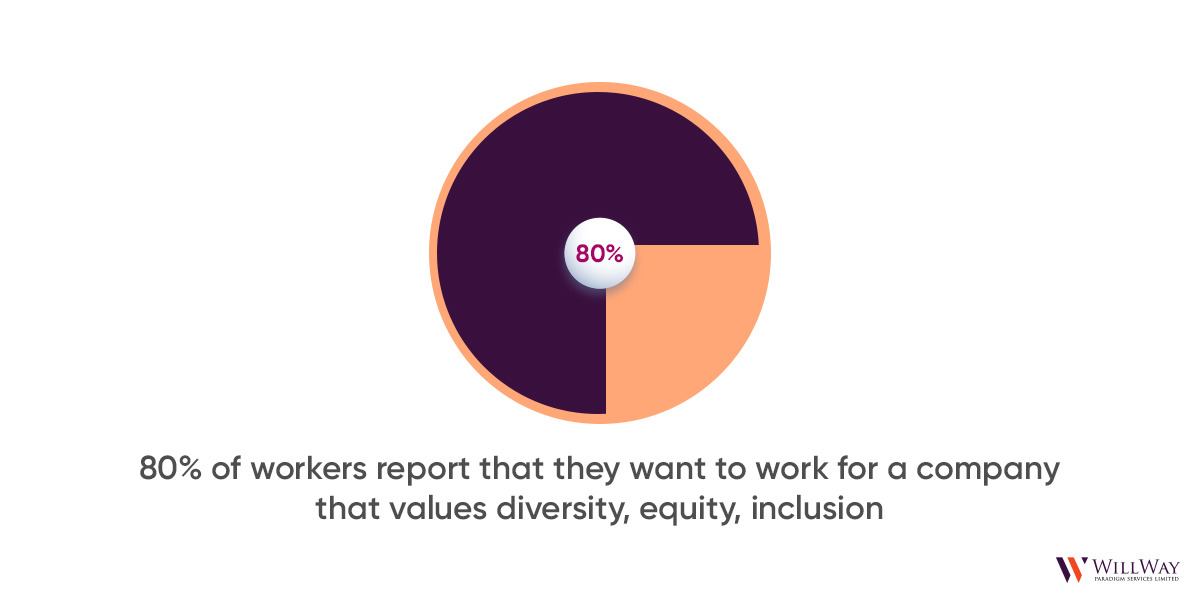
Equity, a Tool for Sustainable Business Growth and Development.
It is safe to say that existing corporations like the oil refineries in America, the train stations in Japan or the great pyramid or Giza were built largely by hands with the same national background at best. However as work evolves into a global activity, pooling talents from different facets of life, it has become imperative to accommodate them in a way that ensures their safety and improves their quality of life and work. It’s become essential for organisations to understand how to cultivate a sustainable work environment that allows ALL team members to thrive.
Nearly 80% of workers report that they want to work for a company that values diversity, equity, inclusion, and belonging (DEIB). In the past couple of years, focusing on a more equitable workplace has become more important for many organizations. Achieving workplace equity is not only a plus for society as a whole, but also an imperative for sustainable business growth. It is important to note that a diverse and inclusive workplace leads to better decision-making and increased innovation, which in turn improves customer experience. By creating a work environment where everyone feels valued and included, organizations can tap into the full potential of its employees and better serve its customers.
What is equity in the workplace?
Equity in the workplace is the idea that all employees are provided with fair and equal opportunities based on their individual or group needs. Equity recognizes that not all employees are afforded the same opportunities and addresses the imbalance of opportunities available to them.
Workplace equity starts by closing racial, gender, disability, ethnic, age gaps in employee treatment, pay, quality of work/life and advancement. But equity also looks at critical initiatives like the unconscious bias that impacts employee performance. We all carry bias that influences our decisions, mindsets, and behaviours. Equity recognizes this truth and refers to a distribution or allocation of resources and opportunities to create a level playing field.
How does equity benefit organisations and employees?
The bottom line is workplace equity is a good thing. While creating a sustainable and equitable workplace will take some hard work, the result is worth the effort. Workers like working for places that feel like they want to invest in them.
Data show that employees who feel they belong in a workplace have 34% higher intent to stay at their organization and are 167% more likely to recommend their company as a place for others to work. Rightly so, more companies are taking on the work of becoming more equitable. And more workers want to work for organizations that value equity, according to a 2021 CNBC/SurveyMonkey workforce survey.
Almost 80 per cent of the respondents to the CNBC/SurveyMonkey poll said they wanted to work for a company that values diversity, equity, and inclusion.
McKinsey & Co. 2019 analysis also found that companies in the top quartile for gender diversity on executive teams were 25 per cent more likely to have above-average profitability than those in the fourth quartile. It also helps a company manage its multigenerational workforce. Equity in the workplace has ensured that companies can have 3-5 generations of tenured and young staff working together to boost ideas and productivity.
Due to this increased demand for equity, taking the time to make a company more equitable will improve its imaging, leading to a more diverse and talented workforce.

Benefits of Equity to the Organisation.
Increase Customer Satisfaction
With the increase in your problem-solving abilities and innovative creativity that increased diversity brings your business will ultimately increase customer satisfaction. Diversity in tenured and younger staff will also expand the net of experience so customer-related problems are resolved quicker. You can also note the increase in your revenue, as you continue to improve upon your services and products, solve your customers’ pain points, and meet their needs.
As a result, you’ll increase revenue and customer lifetime value by increasing repeat clients and attracting new business.
Appeal to More Investors
When it comes to monitoring and selecting the companies they support, investors today are keeping an increasingly close watch on environmental, social, and corporate governance (ESG), and diversity and inclusion practices play an integral part in the way in which investors assess a company’s ESG.
The more diversity you cultivate in your workplace and the more policies promoting diversity you include in your human capital management strategy, the more attractive you will be to potential investors.
Attract Top Talent
When your company displays diversity across spectrums (age, gender, and ethnicity), you strengthen your business’s appeal to more groups of people and effectively increase the talent pool from which you hire.
Before the labour shortage and turnover surge we’re facing today, there was fierce competition for attracting the most qualified candidates into your business. Now that just about every company has a “help wanted” sign posted in its window, competition is tighter than ever and the power of choice truly lies with the talent.
5 ways to promote equity in the Workplace
- Drive awareness around equity in the workplace:
Workers who are interested in improving equity in the workplace should work together to talk to others about the importance of the concept. Leaders should lead by example and show their support for equity and inclusion initiatives. Without an awareness of where you’re starting from, it’s hard to set goals for where you’d like to go. - Evaluate workplace equity:
Take the time to measure how equitable your workplace is. Is workplace leadership accommodating to women and persons with disabilities? Is there a financial or incentive-based reward system in place? Is the pay equitable? Does the organization have a diverse workforce of people of different races, ethnicities, religions, economic backgrounds, gender, age etc?
It’s OK to take an honest look at the organization and evaluate where its weaknesses are in terms of equity. If the company doesn’t have a ton of workforce metrics to review, conducting an employee engagement survey on equity to help determine where things stand. - Prioritize wage equality:
When many people think of workplace equity they think of pay equity. One of the quickest ways to get the ball rolling on making a workplace more equitable is by prioritizing wage equality. Despite some progress over the last few decades, racial and gender-based pay gaps still persist.
A good first step to tackling the wage gap is by trying to remove any stigma around discussing salary in the workplace. Colleagues should be able to share how much they make and compare salaries to others in similar roles to see if everyone is being paid fairly or based on the criteria. - Prioritize equitable representation among the workforce:
A reputable company must establish a company of leaders, layered leadership should be the policy for all companies and should be inclusive of talents from all backgrounds and age groups. Leadership changes should be made to reflect a new commitment to diversity and inclusion.
Workplace leadership should also evaluate whether or not there are diverse employees. Look at workplace data to gain a deeper understanding of workforce demographics.
Again, a company-wide survey on workforce representation could be helpful in determining where the organization could be doing better in terms of making sure that there are diverse employees and all ethnicities, and genders are represented, and whether there are employees that are neurodiverse. - Examine your onboarding process:
Onboarding is a great and sustainable way to introduce new hires to the company culture and is typically where new workers learn lofty things like the company’s mission and values and more practical things like co-workers and HR protocols.
Onboarding is typically standardized to expedite how quickly new hires can get to work. It is also done this way to ensure that all newcomers feel as if they are on the same page. Companies/HR teams can make conversations about equity and share the effort of the company towards driving it. This can range from lectures to modifying office space to foster inclusivity.


